Every one and a half years, enthusiasts see AMD and NVIDIA release the latest series of graphics cards. As such, AMD’s latest Radeon RX 7000 series graphics cards are the talk of the town. However, how do they fare against NVIDIA’s previous-gen GPUs? Therefore, we’re testing the RX 7900 XT Vs RTX 3080 GPUs to find out.
Key Takeaways
- The NVIDIA GeForce RTX 3080 is one of the high-end GPUs from NVIDIA’s previous 3000 series lineup. On the other hand, the AMD Radeon RX 7900 XT is one of the high-end GPUs from AMD’s latest lineup.
- The AMD Radeon RX 7900 XT completely plummets the NVIDIA GeForce RTX 3080 in gaming performance at 1440P and 4K resolutions.
- The AMD Radeon RX 7900 XT is ~9C cooler than the NVIDIA GeForce RTX 3080.
- The AMD Radeon RX 7900 XT is ~28.6% more expensive in terms of MSRP.
- While the AMD Radeon RX 7900 XT has more RT cores, the NVIDIA GeForce RTX 3080 might have better raytracing capabilities.
Architectural Differences
Because both graphics cards we’re testing are from different companies, several architectural differences exist. Moreover, these differences cause a rift in performance, which is why they’re important for consumers to know when making a purchase. For example, if you’re interested in raytracing, AMD graphics cards might not be suited to your requirements.
Also Read: RTX 4080 Vs RX 6900 XT
RDNA 3 — AMD Radeon RX 7000 Series Architecture
Since their failed “Vega” graphics cards, AMD’s RDNA technology has gained traction with their 6000 series GPUs. With added benefits and an introduction to raytracing and upscaling technologies, RDNA 2 competed on par with NVIDIA’s GeForce RTX 3000 series GPUs. AMD has launched its latest RDNA 3 graphics cards, which offer greater performance.
With the latest multi-chiplet design, AMD has produced better graphics cards without exponentially increasing costs.
Memory Cache Die
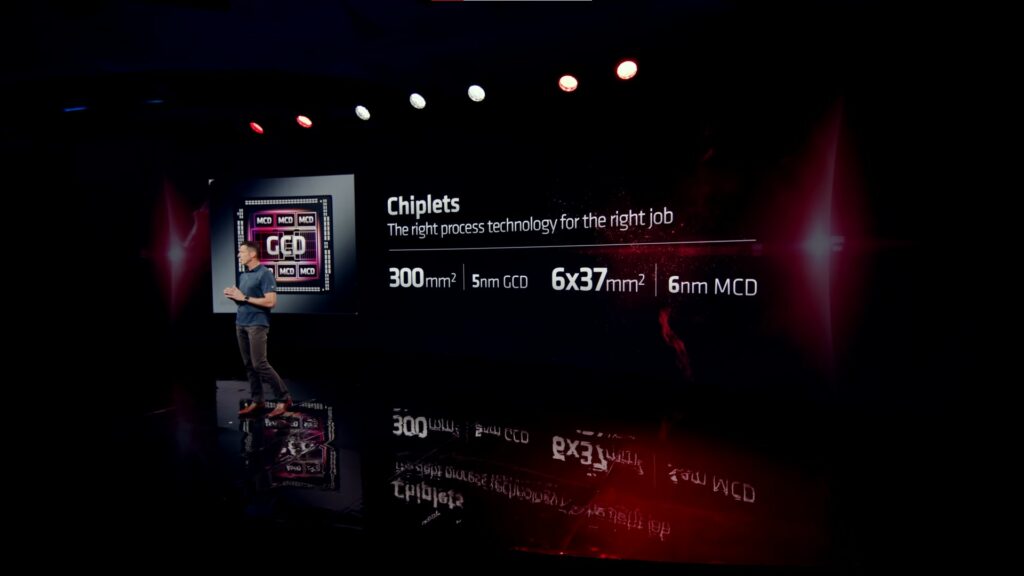
AMD has taken inspiration from its Ryzen processors by enveloping a new chiplet design for its Radeon 7000 series GPUs. To explain, RDNA 3 offers multiple dies, named “Memory Cache Dies” (MCD). Each MCD contains 16MB of Infinity Cache. That equals 80MB of L3 Cache in the Radeon RX 7900 XT.
Furthermore, the RDNA 3 has a single die that contains all the GPU cores, called the “Graphics Compute Die” (GCD). However, the GCD is based on TSMC’s 5nm process node. On the other hand, the MCD is based on TSMC’s 6nm process node. Because the latter is older technology, it’s cheaper for AMD to mass-produce MCDs, dropping overall costs.
Also, as the GCD houses all of the GPU cores, higher transistor density due to the 5nm process node should help improve performance.
Also Read: RTX 3080 Vs RX 6800 XT
AI Accelerators
Another new feature with AMD’s Radeon RX 7000 series GPUs is the AI accelerators. Every Compute Unit (CU) has two raytracing accelerators and one AI accelerator. While these AI accelerators’ exact motive is unclear, we can assume they will improve AMD’s FSR 3.0 technology.
Another use for these AI accelerators can be centered around GPU-based machine learning. Because NVIDIA and Intel have extremely powerful upscaling technologies such as DLSS and XeSS, AMD might use these accelerators to improve its FSR technology.
Until RDNA 2’s Radeon RX 6000 series GPUs, AMD was infamous for relying on its spatial FSR filter. Due to that, FSR could never match DLSS’ level. However, we might see FSR overthrow DLSS with new updates.
Nonetheless, with AMD’s AI accelerators, we may see that for the usage of FSR, users must have GPUs that contain these accelerators, similar to NVIDIA’s tensor cores.
Fidelity FX Super Resolution 3.0

In recent years gamers have seen various software-oriented technologies released to help improve the gaming experience. Raytracing and upscaling technologies have almost completely changed how enthusiasts used to choose graphics cards. However, in AMD’s case, raytracing is a lost hope, but its upscaling technology has the potential to rival its competitors.
AMD released its Fidelity FX Super Resolution (FSR) technology with the Radeon RX 6000 series GPUs. While FSR held potential, because AMD did not have dedicated technologies to upscale frames, they relied on their spatial FSR filter. However, we’re seeing AI accelerators and Fluid Motion Frames with the latest FSR 3.0 for RX 7000 series GPUs.
While almost no information on Fluid Motion Frames has been released, AMD has stated the technology will help generate unique frames on its own. AMD has also shared that Fluid Motion Frames utilizes frame generation similar to NVIDIA’s recently released DLSS 3.0.
Ampere — NVIDIA RTX 3000 Series Architecture
As part of the tradition, NVIDIA developed their RTX 3000 series GPUs codenamed “Ampere” almost two years ago. While the GPUs launched in 2020, they have started to gain attraction now due to AMD’s latest releases. However, pricing and thermal efficiency have confused consumers about which side to choose.
In any case, NVIDIA’s RTX 3000 series GPUs come with certain technologies, such as DLSS 2.0, with a neverending fluctuating price.
DLSS 2.0
NVIDIA first released their next-gen Deep Learning Super Sampling (DLSS) technology with their RTX 2000 series GPUs. Due to serious frame drops from activating raytracing, DLSS helps negate that side effect. However, the upscaled frames have a lower quality, which can be problematic for a few gamers.
To counter the low-quality upscaling, NVIDIA released the DLSS 2.0 with their RTX 3000 series GPUs. While quality has improved drastically, enabling raytracing is still a bit difficult. For that reason, NVIDIA has gone one step ahead.
Through iterations and updates, NVIDIA has finally unveiled its latest DLSS 3.0 technology along with the Ada Lovelace GPUs. Unlike traditional upscaling, DLSS 3.0 generates entirely new frames to help increase the FPS. The concept is similar to what AMD might be planning with its AI accelerators for FSR 3.0.
But, along with the RX 7900 XT Vs RTX 3080 war, we’re also looking at a DLSS 2.0 Vs FSR 3.0 war. Although the DLSS 3.0 concept is amazing, the output can have less detailed frames, which are visible. While it might not be an issue for some consumers, it can hinder others. On the other hand, DLSS 2.0 is more stable and provides great quality upscaled frames.
Also Read: NVIDIA DLSS Vs AMD FSR
Process Node
One of the biggest anticipations with next-gen hardware is the improvements in the process node. While sometimes we don’t see many improvements, NVIDIA has shortened the gap with their advancement to Samsung’s 8nm process node. To explain, the NVIDIA GeForce RTX 2000 series GPUs utilized TSMC’s 12nm process node.
The smaller the process node, the greater the number of transistors placed on it. Therefore, we see 28.3 billion transistors on the NVIDIA GeForce RTX 3080 graphics card. While it doesn’t hold a candle against AMD’s Radeon RX 7900 XT, housing 57.7 billion transistors, the RTX 3080 has proven its performance time and time again.
Resizable BAR
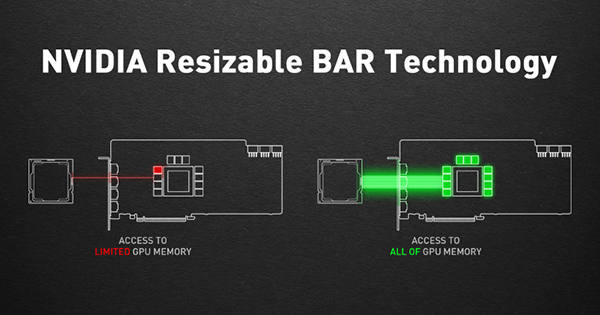
With NVIDIA’s GeForce RTX 3000 series graphics cards, we have seen access to the latest NVIDIA Resizable BAR technology. In simple words, Resizable BAR allows transfers of shaders, textures, and geometry through the VRAM to the CPU without any limits. If you think the concept sounds similar, it’s because AMD’s Smart Access Memory (SAM) does nearly the same thing.
Although the technology is amazing, in practicality enabling Resizable BAR will only improve performance by 2-4%. Even though the performance increment isn’t amazing, free performance is always appreciated. However, it would be best to remember that Resizable BAR is only compatible with Ryzen 5000 series processors and above and anything after Intel’s 10th gen processors.
RX 7900 XT Vs RTX 3080 Specifications
After examining the architectural differences between both GPUs, let’s discuss their specifications. While it’s important to test products in practical environments, knowing their specifications gives consumers an idea of which GPU is better. Also, it becomes easier to find both GPUs’ performance per dollar ratio.
| GPU Name | NVIDIA GeForce RTX 3080 | AMD Radeon RX 7900 XT |
|---|---|---|
| Node | Samsung 8nm | TSMC 5nm (GCD), TSMC 6nm (MCD) |
| Architecture | Ampere | RDNA 3 |
| CUDA Cores/ Stream Processors | 8,704 | 5,376 |
| Core Clock | 1440MHz | 1500MHz |
| Boost Clock | 1710MHz | 2394MHz |
| Memory | 10GB GDDR6X | 20GB GDDR6 |
| Memory Clock | 19 Gbps | 20 Gbps |
| Memory Bandwidth | 760.3GB/s | 800GB/s |
| RT Cores | 68 | 84 |
| Tensor Cores | 272 | N/A |
| Transistors | 28.3 billion | 57.7 billion |
| TDP | 320W | 300W |
| Power Connector | 1 x 12 pin | 2 x 8 pin |
| Launch Date | September 17, 2020 | December 13, 2022 |
| MSRP | $699 | $899 |
| Current Price | $975 | $900 |
Regarding the above chart, we see several interesting differences between the AMD and NVIDIA graphics cards. For example, because the AMD Radeon RX 7900 XT is more recent, it utilizes TSMC’s 5nm process. On the other hand, the NVIDIA GeForce RTX 3080 utilizes Samsung’s 8nm process.
However, if we notice the CUDA cores, the NVIDIA GeForce RTX 3080 has a substantially higher number of CUDA cores than the AMD Radeon RX 7900 XT. Similarly, the Radeon RX 7900 XT has a boost clock of 2394MHz, while the NVIDIA RTX 3080 has a boost clock of 1710MHz.
Furthermore, there is a slight difference in power requirements in favor of the AMD GPU. Lastly, the NVIDIA GeForce RTX 3080’s current price is ~8.3% more than the AMD Radeon RX 7900 XT. So, if the former manages to get over 8.3% faster performance than its competitor, it will have a better performance per dollar ratio.
Gaming Performance At 1440P
As stated above, when comparing two pieces of hardware, we must compare their performance in a practical environment. So, in the case of a GPU comparison, it’s natural to compare their performance in multiple games at different resolutions. Because we’re analyzing high-end GPUs, we shall look at the benchmarks of multiple games at 1440P and 4K resolutions. Benchmark PC Tech has conducted the following 1440P benchmarks.
Testing Rig
- Processor: Intel Core i5-13600K
- Motherboard: ASUS STRIX Z790-F
- RAM: Kingston Fury Renegade RGB DDR5 32GB 6400MHz
- Storage: Samsung 980 SSD 1TB
- Case: Cooler Master H500P
- Graphics Card: AMD Radeon RX 7900 XT & NVIDIA GeForce RTX 3080
Dissecting the specifications of the testing rig, we see the Intel Core i5-13600K serving as the main processor. While the graphics cards being tested are higher-end products, the Intel Core i5-13600K won’t bottleneck either GPU. Also, because a greater 1440P resolution is used, most of the load falls on the GPU. So, a slightly weaker processor shouldn’t change the outcome.
After discussing the processor, we see that the ASUS Strix Z790-F motherboard houses the CPU. Not only is the ASUS Strix Z790-F one of the best motherboards in the market right now, but it also offers amazing compatibility with the Intel Core i5-13600K. Moreover, if necessary, you can easily overclock your Intel 13th gen processors on the ASUS Strix Z790-F.
Now, moving toward the RAM, we have the Kingston Fury Renegade DDR5 kit. Although DDR5 RAM is slightly overkill by current standards, it narrowly improves performance in certain games. So, 32GB of 6400MHz RAM will benefit gaming and productive tasks. Additionally, the Samsung 980 1TB SSD will help decrease game load times.
Lastly, the build is encompassed within the Cooler Master H500P case. Because of the size of the latest GPUs, it is important to buy bigger cases to accommodate these massive blocks of performance. Furthermore, the Cooler Master H500P allows for great air cooling, improving the GPUs’ overall thermal efficiency.
Battlefield V
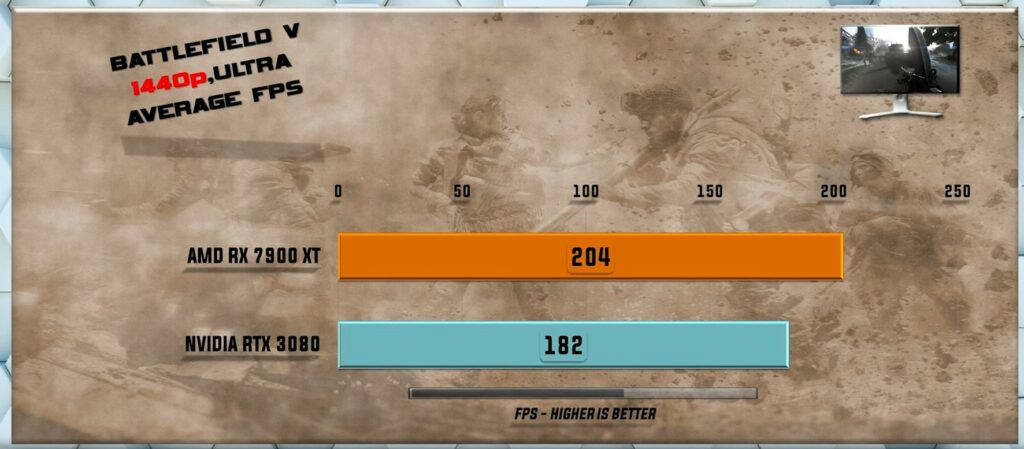
- The AMD Radeon RX 7900 XT averages 204 FPS, whereas the NVIDIA GeForce RTX 3080 averages 182 FPS.
- The AMD Radeon RX 7900 XT is ~12.08% faster than the NVIDIA GeForce RTX 3080.
- In contrast, the NVIDIA GeForce RTX 3080 is ~8.3% more expensive yet loses to the AMD Radeon RX 7900 XT.
Red Dead Redemption 2
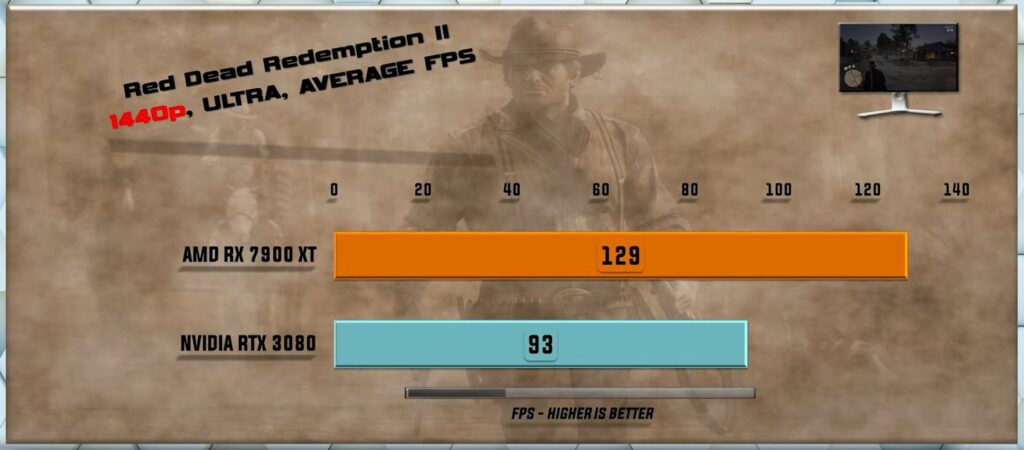
- The AMD Radeon RX 7900 XT averages 129 FPS. On the other hand, the NVIDIA GeForce RTX 3080 averages 93 FPS.
- The AMD Radeon RX 7900 XT is ~38.7% faster than the NVIDIA GeForce RTX 3080 in Red Dead Redemption 2.
Far Cry 6
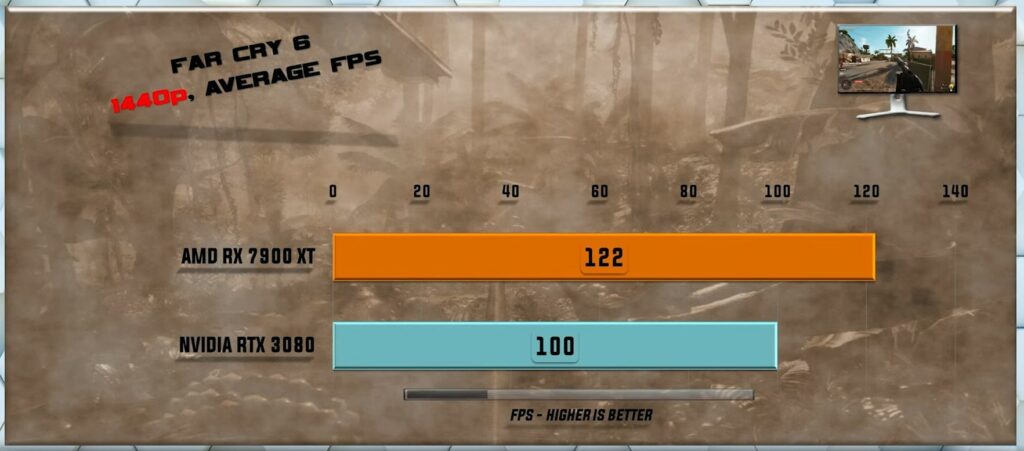
- The gap widens with the AMD Radeon RX 7900 XT averaging 122 FPS, whereas the NVIDIA GeForce RTX 3080 averages 100 FPS.
- The AMD Radeon RX 7900 XT keeps the lead by being ~22% faster than its competitor in Far Cry 6.
God Of War
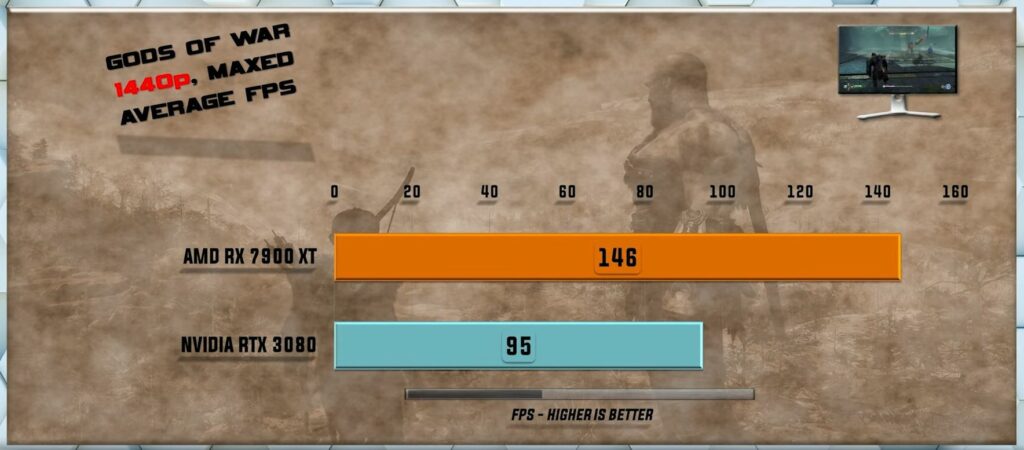
- The AMD Radeon RX 7900 XT thrashes its rival by averaging 146 FPS. Meanwhile, the NVIDIA GeForce RTX 3080 averages 95 FPS.
- While the NVIDIA GeForce RTX 3080 costs ~8.3% more, the AMD Radeon RX 7900 XT is ~53.68% faster in God of War.
Assassin’s Creed Valhalla
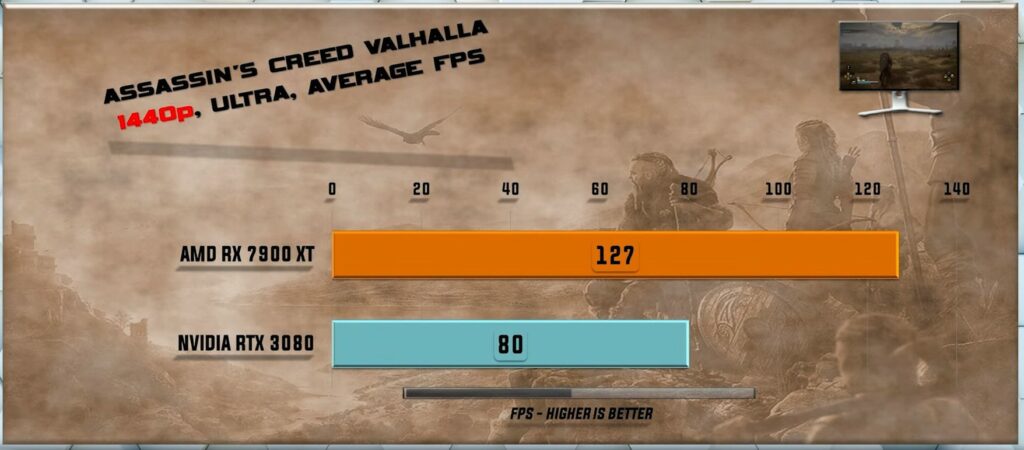
- The AMD Radeon RX 7900 XT averages 127 FPS, whereas the NVIDIA GeForce RTX 3080 averages 80 FPS.
- The AMD Radeon RX 7900 XT Vs RTX 3080 war rages on, with the RX 7900 XT being ~58.75% faster in Assassin’s Creed Valhalla.
Microsoft Flight Simulator

- The AMD Radeon RX 7900 XT wavers with an average of 53 FPS. Moreover, the NVIDIA GeForce RTX 3080 gains ground by averaging 51 FPS.
- The AMD Radeon RX 7900 XT is ~3.9% faster than the NVIDIA GeForce RTX 3080 in Microsoft Flight Simulator.
- While the gap was wider, Microsoft Flight Simulator is a more CPU-intensive game, dropping the overall FPS.
Hitman 3
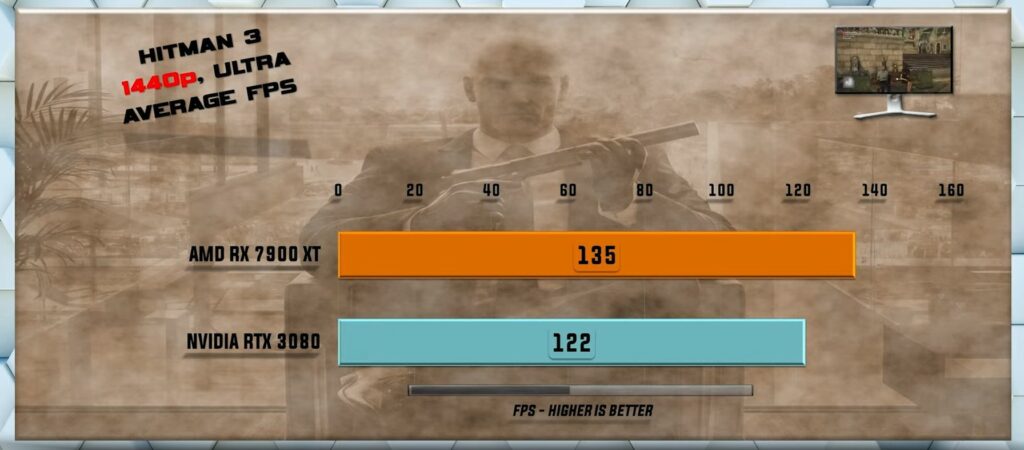
- The AMD Radeon RX 7900 XT averages 135 FPS, while the NVIDIA GeForce RTX 3080 averages 122 FPS.
- The AMD Radeon RX 7900 XT is ~10.65% faster than its competitor in Hitman 3.
Gaming Performance At 4K
After looking at the performance benchmarks at 1440P resolution, we must evaluate the differences at 4K resolution. While the AMD Radeon RX 7900 XT was dominant in all of the games at 1440P, the situation may reverse when the resolution is changed. It is also important to note that none of these benchmarks utilize raytracing and DLSS. Mark PC has conducted the following tests.
Testing Rig
- Processor: Intel Core i9-12900K
- RAM: 2x16GB DDR4 3600MHz G.Skill
- Storage: Samsung 980 Pro
- Graphics Card: AMD Radeon RX 7900 XT & NVIDIA GeForce RTX 3080
Analyzing the testing rig, we see the Intel Core i9-12900K processor. Unlike the 1440P testing rig, the Intel Core i9-12900K is the strongest CPU of its generation. However, comparing the Intel Core i9-12900K Vs i5-13600K might prove more useful. In any case, because the tests are conducted at a higher resolution, the processor should not hinder the benchmarks.
Now, moving toward the RAM, we have the G.Skill 3600MHz 32GB DDR4 kit. Although a DDR5 kit would have been beneficial, the performance increment is negligible. Therefore, 32GB DDR4 RAM is enough for gaming purposes. Although, you would require more RAM if you want to do productive tasks. If the DDR4 RAM worries you, look at our DDR4 Vs DDR5 RAM comparison! Also, the SSD storage will help with decreased load times, saving a lot of time.
Lastly, as we do not know which CPU cooler and case are being utilized, we can’t be sure how good the cooling will be. But, when handling higher-end products, either an AIO or flexible air-cooling should be the way to go. Due to the increased thermal requirements of the latest-gen graphics cards, a few fans barely cut it.
God Of War
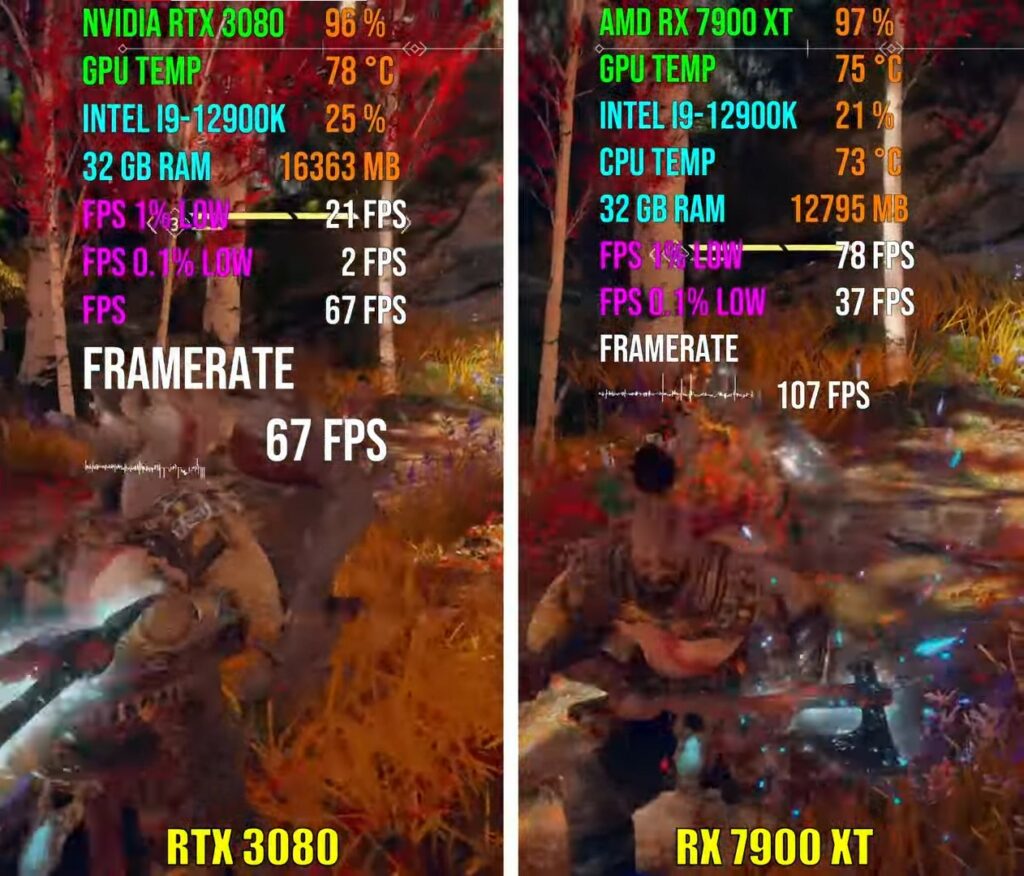
- The AMD Radeon RX 7900 XT averages 107 FPS, while the NVIDIA GeForce RTX 3080 averages 67 FPS.
- The AMD Radeon RX 7900 XT is ~59.7% faster than its competitor at 4K resolution in God of War.
- The NVIDIA GeForce RTX 3080 has an average temperature of 78C. On the other hand, the AMD Radeon RX 7900 XT has an average temperature of 75C.
Cyberpunk 2077
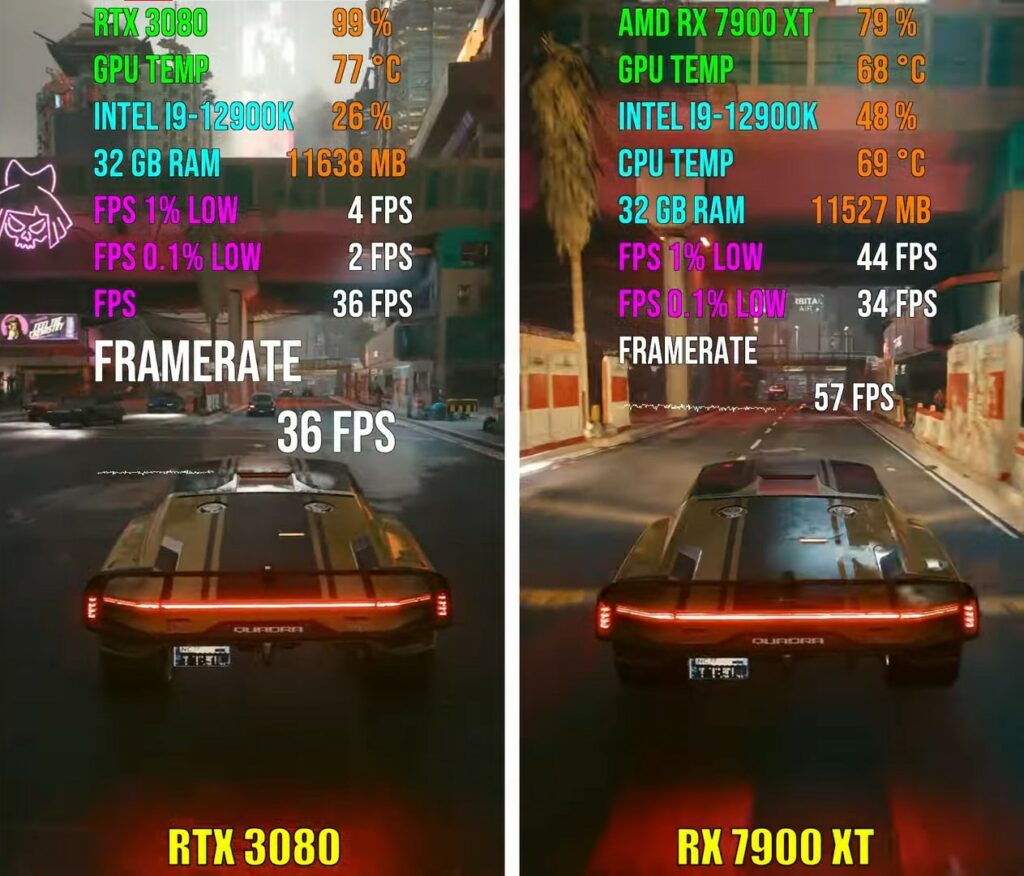
- The AMD Radeon RX 7900 XT averages 57 FPS, and the NVIDIA GeForce RTX 3080 averages 36 FPS.
- The AMD Radeon RX 7900 XT is ~58.3% faster than the NVIDIA GeForce RTX 3080 in Cyberpunk 2077.
- The NVIDIA GeForce RTX 3080 averages 77C, while its competitor averages 68C.
- Although both GPUs fall under the high-end segment, neither can push Cyberpunk 2077 to 60 FPS at 4K resolution with DLSS and RTX off.
Assassin’s Creed Valhalla
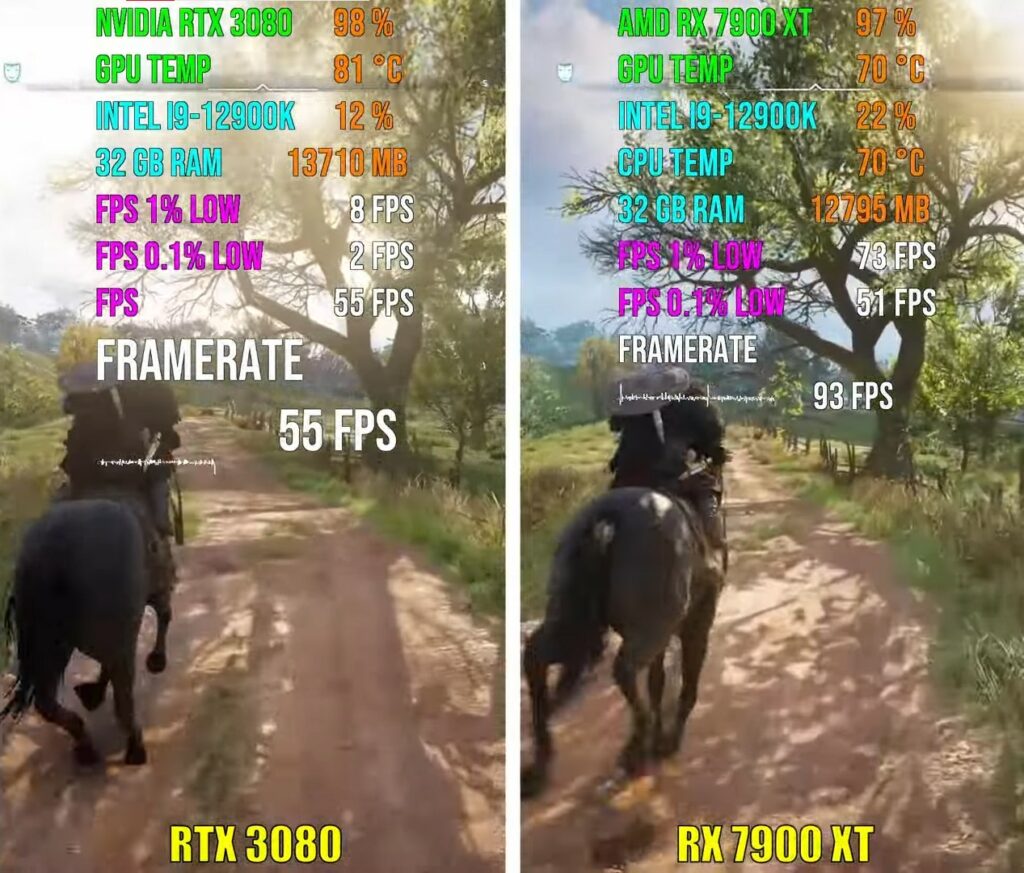
- The AMD Radeon RX 7900 XT averages 93 FPS. Whereas the NVIDIA GeForce RTX 3080 averages 55 FPS.
- The AMD Radeon RX 7900 XT is ~69% faster than the NVIDIA GeForce RTX 3080 in Assassin’s Creed Valhalla. It is ~10.25% faster in 4K than in 1440P resolution.
- The NVIDIA GeForce RTX 3080 has an average temperature of 81C. On the other hand, the AMD Radeon RX 7900 XT has an average temperature of 70C.
Watch Dogs Legion
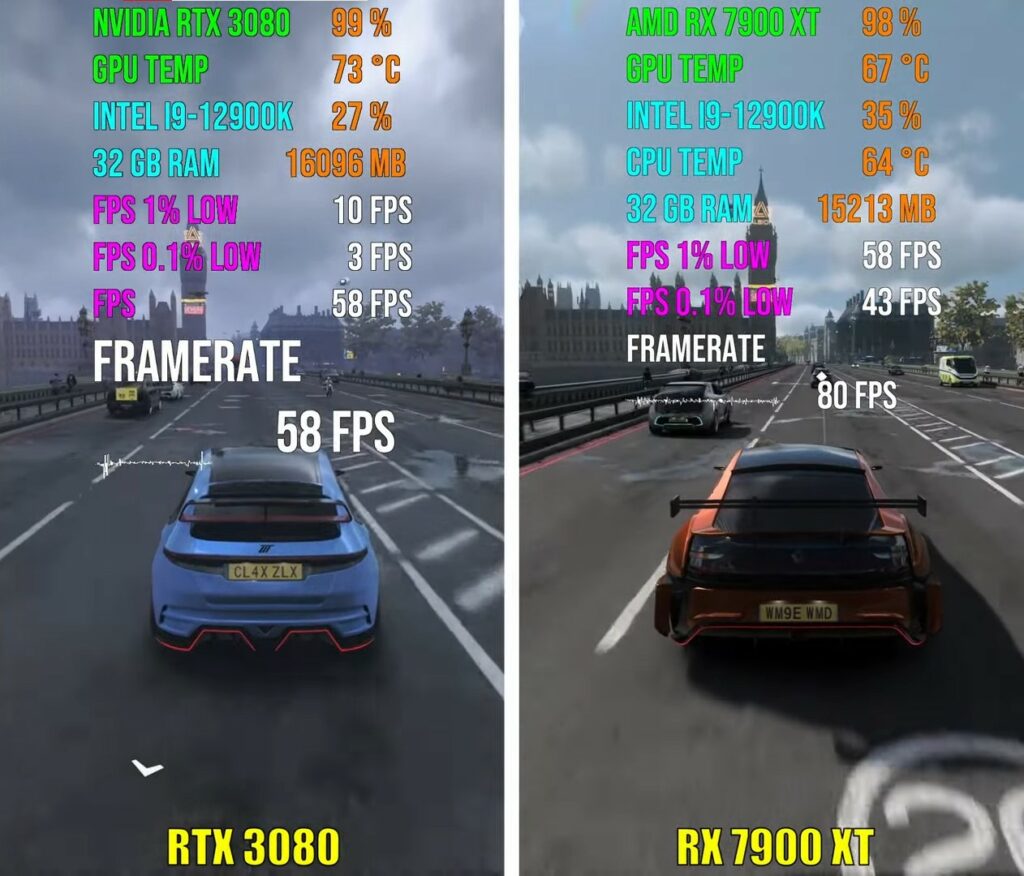
- The AMD Radeon RX 7900 XT averages 80 FPS, while the NVIDIA GeForce RTX 3080 averages 58 FPS.
- The RTX 3080 closes the distance slightly, but the AMD Radeon RX 7900 XT is still ~37.9% faster in Watch Dogs Legion.
- The NVIDIA GeForce RTX 3080 averages 73C, whereas the AMD Radeon RX 7900 XT averages 67C.
- Although the NVIDIA GeForce RTX 3080 is a high-end GPU, it cannot break the 60 FPS wall at 4K resolution.
Red Dead Redemption 2
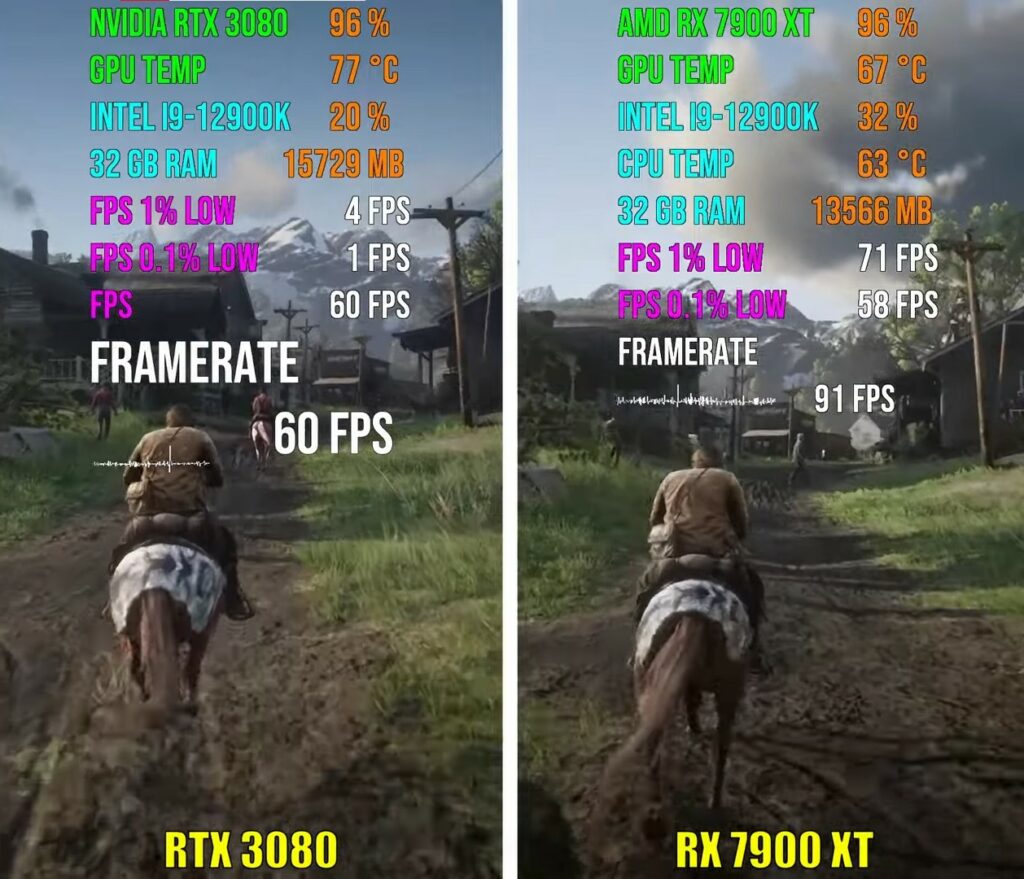
- The AMD Radeon RX 7900 XT Vs RTX 3080 war wages on, with the former averaging 91 FPS. Meanwhile, the NVIDIA GeForce RTX 3080 averages 60 FPS.
- The AMD Radeon RX 7900 XT is leagues ahead, being ~51.8% faster than its rival in Red Dead Redemption 2 at 4K resolution.
- The NVIDIA GeForce RTX 3080 has an average temperature of 77C. On the other hand, the AMD Radeon RX 7900 XT has an average temperature of 67C.
Doom Eternal
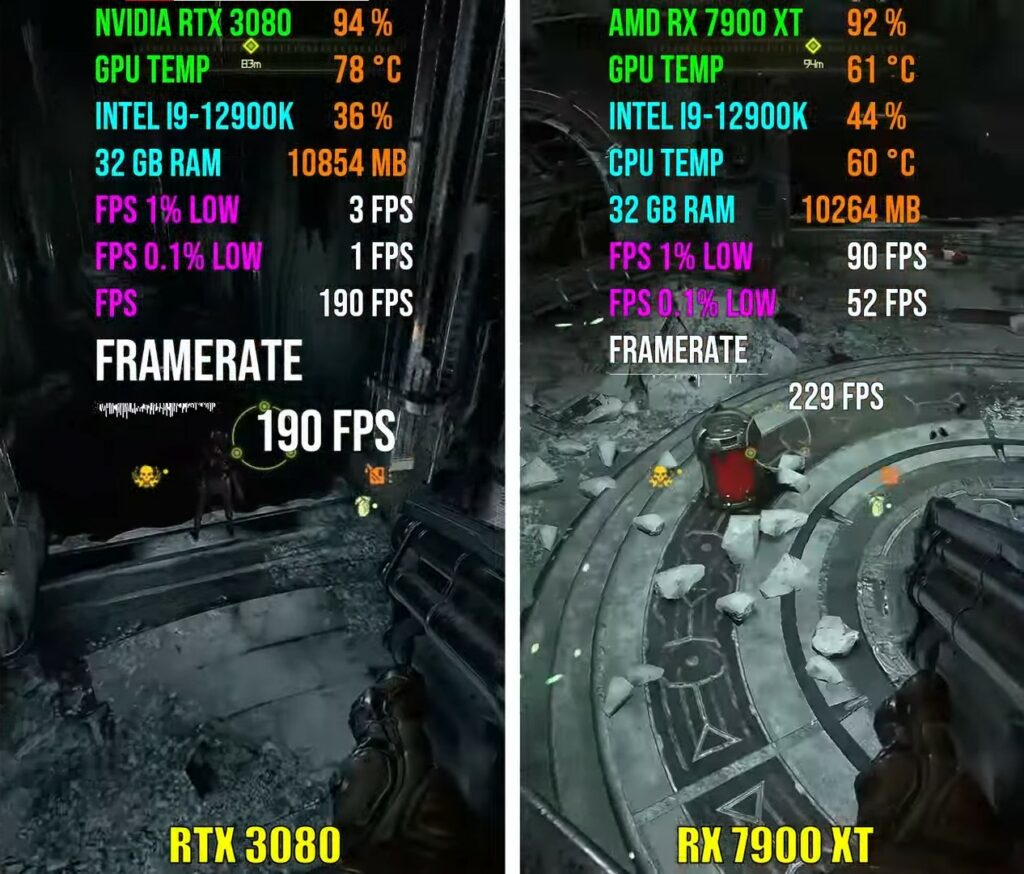
- The AMD Radeon RX 7900 XT averages 229 FPS, whereas the NVIDIA GeForce RTX 3080 averages 190 FPS.
- The AMD Radeon RX 7900 XT stays in the lead by being ~17% faster than its competitor in Doom Eternal.
- The NVIDIA GeForce RTX 3080 averages a temperature of 78C. Meanwhile, the AMD Radeon RX 7900 XT averages a temperature of 61C.
Horizon Zero Dawn
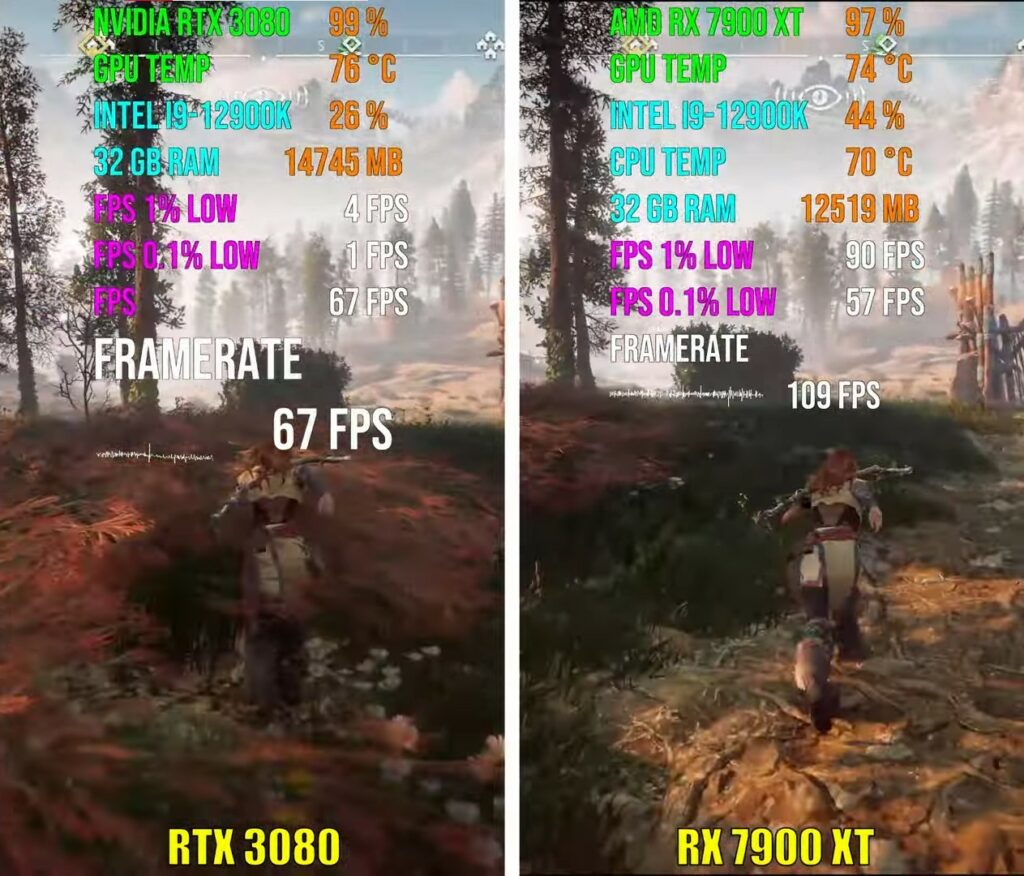
- The AMD Radeon RX 7900 XT averages 109 FPS, while the NVIDIA GeForce RTX 3080 averages 67 FPS.
- The AMD Radeon RX 7900 XT is ~62.6% faster than the NVIDIA GeForce RTX 3080 in Horizon Zero Dawn.
- The NVIDIA GeForce RTX 3080 has an average temperature of 76C. On the other hand, the AMD Radeon RX 7900 XT has an average temperature of 74C.
Overall Gaming Performance
After checking all the benchmarks and looking at their performance, let’s analyze the overall performance of both GPUs. While the AMD Radeon RX 7900 XT has performed magnificently, the NVIDIA GeForce RTX 3080 is no pushover. Let’s look at the results of the various things we looked at during the benchmarking process.
FPS
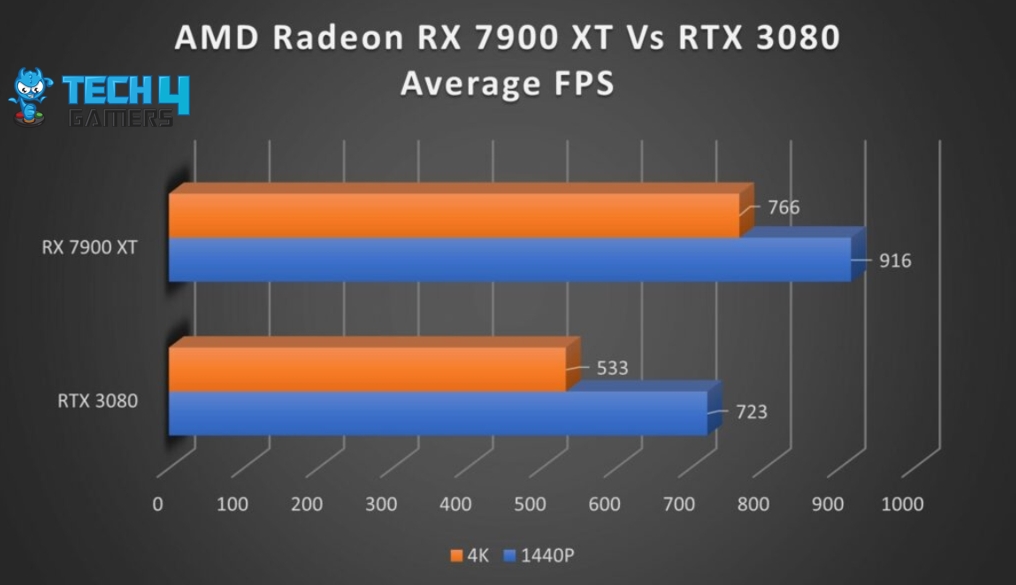
The results are pretty obvious when we see them through a graph. Not only does the AMD Radeon RX 7900 XT dominate the NVIDIA GeForce RTX 3080 in 1440P resolution, but also in 4K. To explain, the AMD Radeon RX 7900 XT is ~26.9% faster than its competitor in 1440P resolution by averaging 916 FPS against 723 of the RTX 3080. Also, the RX 7900 XT is ~43.7% faster in 4K resolution, averaging 766 FPS against 533 of the RTX 3080.
On the other hand, the NVIDIA GeForce RTX 3080 is ~8.3% more expensive than the AMD Radeon RX 7900 XT. So, regarding rasterization performance, the AMD GPU wins by a massive margin.
Also Read: Best RTX 3080 Graphics Cards
Thermal Efficiency
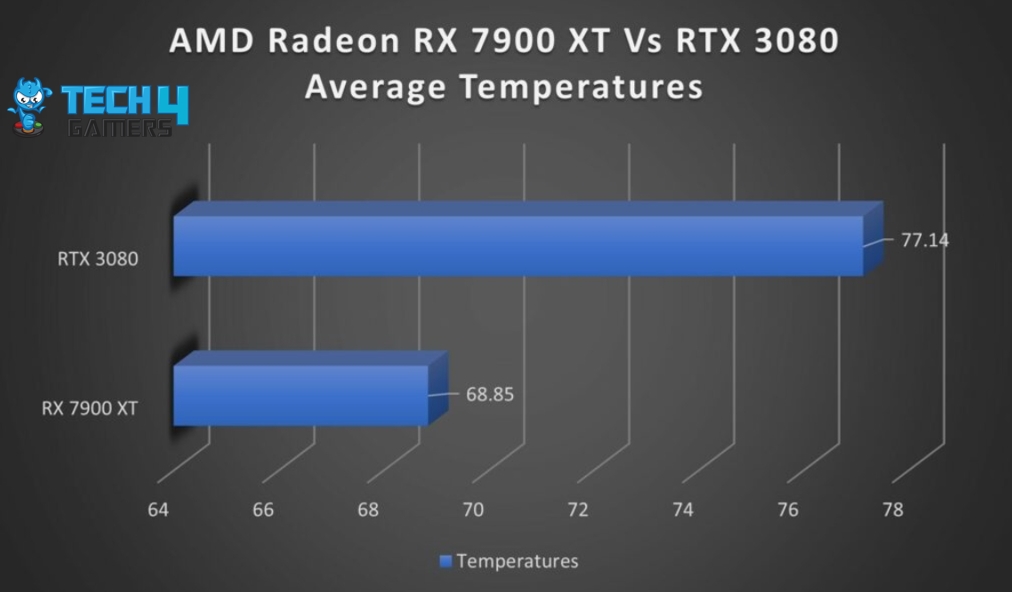
Looking at the temperatures in all the 4K benchmarks, we realize that the AMD Radeon RX 7900 XT has lower temperatures. Lower temperatures increase the total time a GPU can stay at full load. Also, lower temperatures allow for greater overclocking capabilities.
So, the AMD Radeon RX 7900 XT defeats the NVIDIA GeForce RTX 3080 in performance and thermal efficiency. While the NVIDIA GeForce RTX 3080 has lower temperatures in certain games, the average is significantly higher than its competitors. On the other hand, the AMD Radeon RX 7900 XT showcases similar temperatures in all games, being more consistent.
More Comparisons: RTX 4080 Vs RTX 3080 Ti
Price And Availability
Now, the prices fluctuate significantly after looking at both graphics cards’ performance per dollar value and availability. To explain, the NVIDIA GeForce RTX 3080 GPU launched on September 17, 2020, with an MSRP of $699. However, due to an unreasonable increase in demand, the prices have shot up to $975.
Similarly, the AMD Radeon RX 7900 XT launched on December 13, 2022, with an MSRP of $899. Over the month, the price hasn’t changed, and you can easily find one for $900 in the market.
So, currently, the NVIDIA GeForce RTX 3080 is ~8.3% more expensive than the AMD Radeon RX 7900 XT. Although looking at the performance benchmarks, the AMD Radeon RX 7900 XT shows superiority in every field, making it a solid purchase.
Nevertheless, if looking at availability, both graphics cards are easily available on marketplaces such as Amazon and Newegg. Therefore, you can purchase from there or look around your local shops to find a better deal.
Which One Should You Go For?
After going through all the benchmarks for the AMD Radeon RX 7900 XT Vs RTX 3080 GPUs, it’s time to decide the winner. The graphics card you should purchase depends on your requirements. However, if raw rasterization performance is your main requirement, then the AMD Radeon RX 7900 XT wins by a huge margin.
Moreover, if you want to purchase a GPU with a better performance per dollar value, then the AMD Radeon RX 7900 XT is better because it costs ~8.3% less yet performs significantly better.
Additionally, if you are concerned with thermal efficiency, then the AMD Radeon RX 7900 XT might be the better option due to its lower temperatures. So, going with the AMD Radeon RX 7900 XT should be your first choice under these conditions.
Regardless, if raytracing and upscaling technology are your main requirements, then the NVIDIA GeForce RTX 3080 might be the better option. Until AMD releases its FSR 3.0 technology, DLSS will remain the better option.
In conclusion, which GPU you should purchase depends solely on your requirements. For that reason, in-depth research is often required before purchasing.
Also Read: RTX 4080 Vs RX 6950 XT
Frequently Asked Questions
At most, you need an 800W power supply to use the RX 7900 XT without any problems. If you have a PSU weaker than 800W, you might want to upgrade. In case you’re unsure, this guide on how much power a gaming PC requires should help you.
Because DLSS works on machine learning, no RTX 3000 series GPU supports DLSS 3.0, including the RTX 3080.
While the possibility of fitting an AMD Radeon RX 7900 XT in an SFF case exists, it depends on the exact measurements of the chassis. For reference, the AMD Radeon RX 7900 XT has a length of 276mm, a width of 135mm, and a height of 51mm.
Thank you! Please share your positive feedback. 🔋
How could we improve this post? Please Help us. 😔
[Comparisons Expert]
Abdemanaf is a skilled creative writer who has been honing his craft since 2011. While initially working in different fields, he found a passion for technology and has been exploring the tech world since early 2015. Over the years, he has developed an in-depth knowledge of the latest tech trends and product offerings by various companies.
Abdemanaf’s writing reflects his analytical mindset and ability to think critically. He has a knack for breaking down complex technical information into easily digestible pieces, making his articles engaging and accessible to readers from all backgrounds. In February 2022, he joined Tech4Gamers as a blog and product comparison writer, where he has been able to hone his skills further.
As a writer, Abdemanaf is dedicated to staying up-to-date with the latest technological advancements and trends, enabling him to provide readers with the most relevant and accurate information. He is always eager to learn more and is constantly seeking new challenges to improve his skills.
Get In Touch: [email protected]


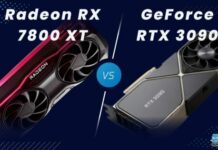
![Core i5-13600k Vs i5-12600K [We Tested 7 Games] Intel Core i5 13600k vs Intel Core i5 12600k](https://tech4gamers.com/wp-content/uploads/2022/11/Intel-Core-i5-13600k-vs-Intel-Core-i5-12600k-218x150.jpg)
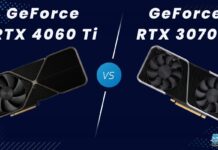
![Core i5-13400 Vs Ryzen 5 7600 [We Tested 9 Games] Core i5-13400 Vs Ryzen 5 7600](https://tech4gamers.com/wp-content/uploads/2023/04/Comparison-1-218x150.jpg)
![RTX 4070 Ti Vs RTX 3080 Ti [Gaming Benchmarks + Overall]](https://tech4gamers.com/wp-content/uploads/2023/01/RTX-4070-TI-VS-3TX-3080-TI-218x150.jpg)
